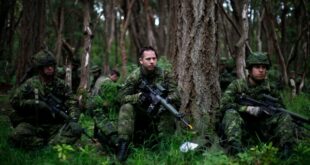2 projects in northwestern Ontario city aim to build affordable, transitional units for Indigenous people.

Thunder Bay, Ont.’s plans for more affordable housing for Indigenous people took a big step forward this week as two levels of government have promised funding for a pair of developments that have been in the works for years.
Provincial Municipal Affairs and Housing Minister Steve Clark joined federal Indigenous Services Minister Patty Hajdu on Monday to announce both governments are spending nearly $4 million combined on 24 affordable units on Huron Avenue. Clark also pledged nearly $9 million in provincial funding for 58 transitional housing units on Junot Avenue.
Both projects, which are for Indigenous people in urban areas, are being led by Ontario Aboriginal Housing Services (OAHS).
Housing has been top of mind for leaders across Canada. Ontario has set the ambitious target of building 1.5 million homes by 2031 and the federal government is considering a cap on the number of international students to ease the pressure on the housing market.
“It’s really, really aggressive given the fact that the best year we’ve had in about the last 30 years was in 2021, when we had just about 100,000 housing starts,” Clark said during Monday’s announcement about the province’s goal.
“The province has to step up, not just with a federal cost-shared program, but on our own,” he said.
For Thunder Bay, that target is 2,200 homes by 2031, and by committing to this number, the municipality will secure strong mayor powers.
‘For Indigenous, by Indigenous’ housing
Thunder Bay’s new transitional units will be for people ages 18 to 29. Of the 58 units, 28 will be high-needs supportive units and the remaining 30 will be for youth transitioning to long-term tenancies. Managed by the Thunder Bay Indigenous Friendship Centre, the three-storey building will include single and pod-style rooms, a communal kitchen, 24-hour youth workers and full-time case managers offering wraparound support.
Of the 24 affordable units on Huron Avenue, 20 per cent will be fully accessible. Each will have a dedicated parking space. The long-term goal is to have up to 70 units on the property, pending additional funding.
Cathy Connor, director of housing for OAHS, said it’s anticipated construction will start this fall and could take between 16 and 18 months to complete. Grand openings at both locations are tentatively slated for February or March 2025.
Projects like these make a big difference in providing culturally sensitive supports, Connor said.

“We know the for Indigenous, by Indigenous approach is instrumental to the success of being able to have our tenants in supportive housing be successful and to move on to long-term tenancies,” she told CBC News in an interview Tuesday.
Hajdu, MP for Thunder Bay-Superior North, said although the affordability crisis sparked by the COVID-19 pandemic is hitting people hard across the country, Indigenous people have felt these pressures much longer.
“This is not a new feeling for many Indigenous people and especially for urban Indigenous people who come to cities for all the reasons that other people come to cities: to get a better education, to be closer to health care, to be closer to family, to be able to partake in different kinds of activities that aren’t available in remote communities,” she said.
“That difficulty to find housing is made even more difficult by the very fact that they are Indigenous.”
Homelessness concerns mounting
As the weather gets colder, outreach workers are concerned about what will happen to the city’s unhoused population. About 140 people were known to be sleeping outside in the city at the end of July.
When CBC News asked Clark about this, he pointed to the province’s additional investments in the Homelessness Prevention Program, which gave the city’s manager of community housing, the Thunder Bay District Social Services Administration Board, a nearly 200 per cent boost.
“It’s a really good indication that our government is listening about the circumstances in Thunder Bay, and the need in Thunder Bay and some of the unique challenges we have in Thunder Bay, so this funding really reflects that,” added Thunder Bay-Atikokan MPP Kevin Holland.

While Monday’s announcements celebrated the two new projects getting off the ground, “we’re ready for the next one already,” said Mayor Ken Boshcoff.
Municipalities have ramped up efforts to engage with people experiencing homelessness through by-name lists. But it remains difficult to gauge the numbers with so many people being transient, said Katie Bortolin, director of housing for the Thunder Bay Indigenous Friendship Centre.
“We know our shelters are filled, transitional houses are filled, the amount of calls that emergency shelters are getting are endless. We know that people are transitioning through the systems of emergency shelter systems, repeatedly going through the cycle,” said Bortolin.
These challenges, she said, are what projects like OAHS’s are aimed at addressing.
Mental health, addictions intersect
Also in Thunder Bay on Monday was the new federal minister of mental health and addictions, Ya’ara Saks. She was appointed to the role last month and said visiting Thunder Bay was a top priority, given the severity of the opioid crisis in the city.
Saks spent the day meeting with local service providers and advocates, many of whom have lived experience of the challenges for which they are seeking solutions, she said.
“Those who have lived experience in Thunder Bay know their communities, they know who gets along, they know where the supports are needed and they also know where someone may be best suited to get the help that they need,” Saks said in an interview with CBC News on Monday.
“What I’ve learned from them is that we need an integrated approach in everything that we do, so that our teams are well supported, but also looking at all of the determinants that contribute to one’s health, which include mental health, which include housing, which include access to primary care.”

Those with lived experience of these challenges have “invaluable knowledge” in coming up with local strategies, and Saks hopes to see more support for them through bilateral funding agreements between the province and Ottawa.
She said it’s important to “tackle this together both at the federal level and the provincial level and also with local groups, because if we aren’t taking care of our [outreach] teams, they can’t help those who are in most need of help right now.”
Meeting people where they’re at
Among local advocates is Kyle Arnold, who has lived experience with homelessness and addiction, and now serves as program co-ordinator for People Advocating for Change Through Empowerment, which runs warming and cooling centres in Thunder Bay’s south end.
As Arnold gears up for International Overdose Awareness Day on Thursday, he said he wants more people to recognize how mental health and addictions intersect with the housing crisis.
“I can name three clients in the last two weeks that got out of jail — they wanna get clean or stay clean, they want help, they know they have addiction issues,” Arnold said. “And where do they go? They’re back on the streets. Nothing was set up for them; they’re just released.
“There’s no housing piece, there’s nothing there.”
As Thunder Bay looks to fill the 2,200-home quota set by the province, Arnold, along with Connor of OAHS, is calling for more units that meet people’s individual needs.
“Everybody is in a different spot in their life and along their personal journeys,” Connor said. “Some people may need and require high-needs supportive housing to be able to move them along the housing continuum. Some people are hard-working people that work every day but they cannot afford market rents, which is why we also offer affordable rents. It’s just a way to be able to meet the needs of different people at different parts of their life.
“That is what Ontario Aboriginal Housing is all about,” she said.
ABOUT THE AUTHOR
Sarah Law is a CBC News reporter based in Thunder Bay, Ont., and has also worked for newspapers and online publications elsewhere in the province. Have a story tip? You can reach her at sarah.law@cbc.ca
*****
Credit belongs to : www.cbc.ca
 Atin Ito First Filipino Community Newspaper in Ontario
Atin Ito First Filipino Community Newspaper in Ontario






